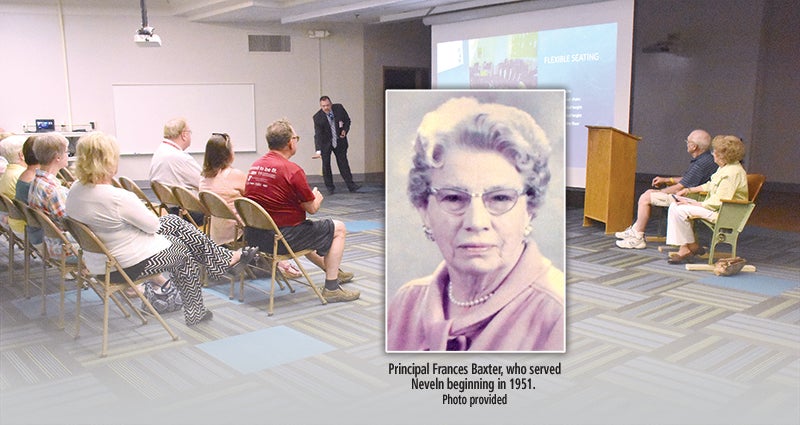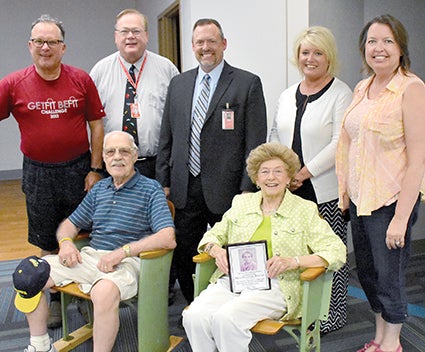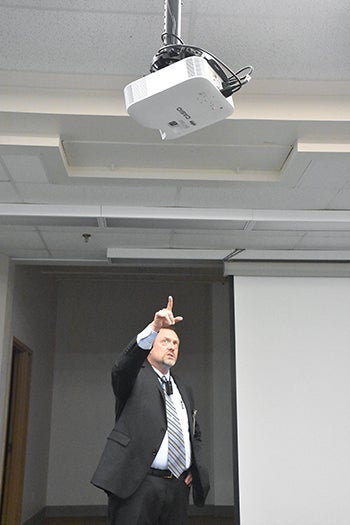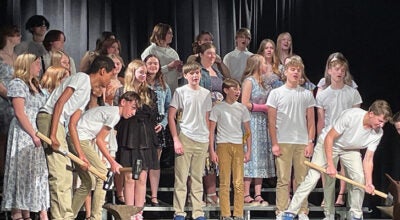A top-notch legacy; Learning Studio dedicated to Baxter
Published 8:57 am Tuesday, June 6, 2017

- Neveln Principal Dewey Schara gives a brief history of the new learning studio, located in a former auditorium at the elementary school. Next year, the school's fourth graders will occupy the space which offers more efficiency, flexibility and cooperative learning. Photos by Deb Nicklay/deb.nicklay@austindailyherald.com
The late Frances Baxter was “an innovator in new spaces, expansions,” said Neveln Elementary Principal Dewey Schara.
She even provided calm and common sense when the school suffered a gas explosion. Fortunately, no one was hurt, he said.
So, it was only appropriate that when a new, innovative space was dedicated on the school’s second floor on Monday, it should be named for her, the first Neveln principal.
On Monday afternoon, officials presented a plaque to Baxter’s niece, Connie Olson, and her husband, Duane, that named the new area the “Baxter Learning Studio.”

Neveln Principal Dewey Schara presented a plaque to Frances Baxter’s niece and husband, Connie and Duane Olson, when the area was renamed in her aunt’s honor. From left, front, Duane and Connie Olson; back, Austin School Board member Don Leathers, Superintendent of Schools Dave Krenz, Schara, and board members Peggy Young and Kathy Green.
“This will be the most technologically advanced classroom in kindergarten-12th grade in the district,” Schara says.
“She was top-notch,” said Schara of Baxter. “I feel we are carrying on the tradition of this building.”
The learning studio, located in a former second floor auditorium, will in the fall become home to 90 fourth-graders, the first class to go through a new learning program.
The renovated area, wired for state-of-the-art sound and computer technology that works through large Smart boards/white boards, is laid with new, colorful carpet. There is a smaller room off to the side that allows for small-group instruction.
Teachers will, over the summer, experiment with different types of tables and chairs to be placed in the area. All of them will be flexible and allowed to move to create spaces in different alignments, Schara said.

Neveln Principal Dewey Schara discusses some of the new equipment installed for the learning suite.
But more importantly, the area will provide space for cooperative and collaborative learning, done in both large- and small groups. Students are expected to take a more hands-on approach to learning, working with others, and taking charge, in many ways, of their own education. “This [cooperative learning] isn’t something that just happens; it’s something that has to be taught,” said Schara. “But we are so excited — when students work cooperatively, they become advocates of their learning, they become even more successful.”
Parents were invited to meetings earlier this year to hear about the changes. While technology is important, it is not the most important part of the space. The relationship of teachers with his or her students is paramount.
“Teachers teach; technology enhances,” Schara said.
While the room is home base for 90 students, there is only a short window every day when all students are in the same area. Science, art, music and physical education are all taught in other areas, so during most of the day, fewer children are in the space. Instructors are Erik La Rock, Carissa Gabrielson and Pam Schwarz, and they have already proven their ability to work well with one another, said Schara. Professional development in advance of the change has already begun, he added.
“They are very excited and will do so well,” Schara said.
It took about $100,000 to renovate the space, he said. Sumner Elementary has learning suites — they are geared to separate learning areas, and both third and fourth grades are included — that operate a little differently, but with the same focus for collaborative instruction and learning, he said.





